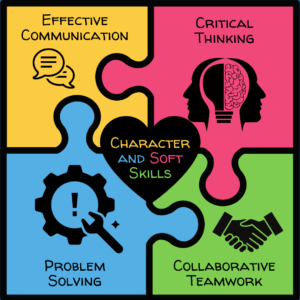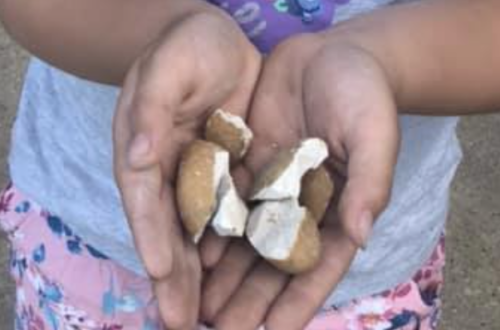
What skills does my child REALLY need to be successful?

This was a question that I asked myself when I first started my homeschooling journey.
At the time, I was teaching Algebra 2 in my local public school, and I realized that most of the skills that we were teaching in that class were not relevant or useful in real life.
So I started to research about which skills are required in order to be successful in today’s modern world, and these are the top 5 skills that I found:
- Effective Communication
- Critical Thinking
- Problem Solving
- Collaborative Teamwork
- Character and Soft Skills
In every article that I read or scientific study that I researched, I kept coming back to these 5 key areas that determined who was successful and who was not.
And the truth is, children can learn ALL of these skills without ever setting foot into a traditional classroom.
Effective Communication
Children learn to be effective in communication by being free to communicate freely. They must be able to express themselves in meaningful ways – whether that be through the written or spoken word or even through gestures or behavior. We can teach children strategies for communication through modeling effective ways to communicate, being in touch with our own emotions, expressing them in healthy ways, and communicating our wants and needs to the people in our lives.
- Can my child accurately identify his or her own emotions? (If you want to help your child identify emotions, check out The Crunchy Kid Learns the Emotions Children’s Book).
- Does my child have strategies for expressing those emotions in meaningful and healthy ways?
- How does my child communicate his or her wants or needs?
Communication is not only about expressing yourself to others. Effective communication also requires that you are able to receive and accurately interpret the communication of others.
- Is my child picking up on social cues and facial expressions?
- Does my child hear and respond to the complaints and concerns of others?
- When people speak, does my child demonstrate active listening by nodding, giving eye contact, and asking relevant questions?
Critical Thinking
Critical thinking is all about questions – learning to both ask and answer them. I often tell my children that an intelligent person is not the person who knows all the answers, but the person who knows how to ask great questions. Oftentimes, asking a great question is more important than discovering the answer.
Ironically, this is one of the skills to disappear the fastest in a forced schooling environment. In schools, the teacher asks the questions, and the students are only required to regurgitate an answer. However, true critical thinking comes as a result of learning to ask questions and to discover the answer.
The most important questions to ask are open-ended questions like “How?” or “Why?”
Metacognition – or “thinking about thinking” – is another important aspect of critical thinking. The ability to think about the way that you think is one of the most transformative practices that a human being can participate in. In order to cultivate metacognition, we must learn to ask great questions of ourselves. We must learn to reflect on the “How” and “Why” of our own thought processes.
As an adult, we can model metacognition by simply communicating our thoughts out loud.
We often will carry on lengthy internal dialogues with ourselves, but by speaking our thoughts and our thought process out loud, we can demonstrate for our children ways that they can begin to think about their own thinking processes.
Problem Solving
Problem Solving is also about learning to ask and answer two important questions: “What is a problem that I care about?” and “What are potential solutions?”
If you’re not sure what problem you care about, then try paying attention to complaining.
Complaining is a sign that there is a problem somewhere.
One day, I was visiting a friend, and while she was breastfeeding her newborn baby, her 3-year-old daughter came up and complained that her little brother was taking her toys.
She simply smiled and said, “It sounds like you and your brother are wanting to play with the same toy at the same time. It also sounds like that is a problem that you can fix! What are some solutions for that problem?”
Her daughter thought for a few seconds and then said, “I could ask him nicely to give it back.”
“Great idea!” she exclaimed. “Can you think of another possible solution?”
“Hmmm… I could give him a different toy to play with.”
“Super! Any other ideas you could try?” she asked.
“I could let him have a turn, and I could play with something else,” the little girl said.
“Sounds great!” my friend said with a smile. “You are great at solving problems! Give those a try, and if they don’t work, then come and see me again, and I will try to help.”
The little girl went bouncing off with a smile and did not return – much to my surprise and amazement.
In that example, I noticed that my friend encouraged problem solving by:
- Hearing the complaint. She listened as her daughter complained about her little brother.
- Identifying the problem. “It sounds like you and your brother are wanting to play with the same toy at the same time.”
- Empowering her child. “That sounds like a problem you can fix!”
- Brainstorming possible solutions. “What are some solutions for that problem?” “Can you think of another possible solution?” “Any other ideas you could try?”
- Encouraging her child. “You are great at solving problems!”
- Supporting her child. “If those solutions don’t work, then come and see me again, and I will try to help.”
- Trusting her child. She let her child try the solutions she came up with on her own and trusted her to be able to solve her own problem.
Collaborative Teamwork
Collaborative teamwork is all about learning how to work in diverse groups. As parents, we can support our children to practice collaborative teamwork by proving opportunities for them to interact with other people. We can do this through:
- play dates
- sports teams
- co-ops
- family game night
- care tasks (since I hate the word “chores”)
- work
- unstructured play time
- church events
- community service
- traveling
- field trips
- and more!
I always thought it was interesting when teachers would say that we are “preparing students for real life.” Because the truth is that there really is no other time in our lives when we are grouped with 20-40 other people simply because of the year we were born.
Real life is messier than that. Children who are homeschooled have the blessing of being able to interact with people of all different ages and backgrounds – from babies to the elderly. What better preparation for real life than that?
Character and Soft Skills
Developing character or “soft skills” is one of the most important things that we can teach our children. Our children learn more by what we do than by what we say, so we must master the art of “show not tell.”
Show your child what it looks like to be a person who is:
- Loving
- Joyful
- Peaceful
- Patient
- Kind
- Good
- Faithful
- Gentle
- Self-Controlled
We cannot expect our children to be what we cannot. Lead by example. You got this!
For more information, check out Episode 10 of the Peaceful Worldschooling Podcast.




